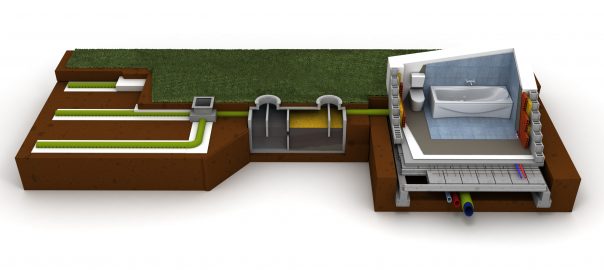When we build a Horizons East Home, we take care to ensure you have great details in your home and underground. For homeowners with septic systems, that includes the use of a quality EZflow® Septic System. Let’s take a look at what your septic system does and how you can ensure a long life.
How Septic Systems Work
Septic systems essentially work as a self-contained waste-water treatment plant in your own back yard. They contain two main parts: a tank and a drain field. The tanks is water-tight with an inlet from the sewer pipe and an outlet to the drain field. The septic tank treats wastewater naturally by holding it in the tank long enough for solids and liquids to separate.
Wastewater in the tank forms three layers. Solids like greases and oils that are lighter than water float to the top forming a layer of scum. Solids heavier than water settle at the bottom of the tank forming a layer of sludge. This leaves a middle layer of partially clarified wastewater. Scum and sludge layers stay in the tank to be broken down by bacteria. The partially clarified wastewater is distributed throughout the drain field through environmentally friendly EZflow® engineered lines.
Benefits of EZflow® Septic Systems
Your EZflow® system is and engineered geosynthetic aggregate system designed to replace traditional stone and pipe drain fields. Because it’s a self-contained perforated pipe surrounded by aggregate that’s held in place with durable, high-strength netting, the system is always clean and free of fines. It’s made from recycled materials and is cost effective to install. The system is engineered for optimal storage and absorption efficiency. It can also be easily contoured around existing trees or other obstacles. Download the spec sheet to learn more about product specifications.
4 Ways to Maintain your Septic System
The EPA recommends 4 ways to care for your septic system. The main items for septic system health are:
- Inspect and Pump Frequently This depends on the size of your home and system, but most septic systems should be professionally inspected every three years.
- Use Water Efficiently Since everything that goes down the drain ends up in the septic system, conserving water helps reduce the load on the system. High-efficiency toilet, washing machines and showerheads all help control the volume of wastewater produced daily.
- Properly Dispose of Waste
Don’t flush any solid waste except for human waste and toilet paper. Make sure grease, oil, wipes, feminine products, dental floss, coffee grounds, and other items are put in the trash not poured down the drain or flushed. - Maintain Your Drain FieldDon’t park, drive or pour concrete over the drain field. Compression will reduce its efficiency. Ensure other water sources like gutters or sump pumps do not empty into the drain field.
You can learn more about how the EPA recommends you care for your septic system here. With a little care and maintenance, your EZflow® system will provide safe and efficient disposal of wastewater for your home and family.


